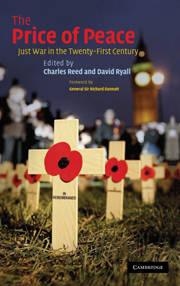Book contents
- Frontmatter
- Contents
- Notes on contributors
- Foreword by Richard Dannatt
- Acknowledgements
- 1 Introduction
- PART I A framework for ethical decision making: state and civil society-based approaches
- 2 The development of just war thinking in the post-Cold War world: an American perspective
- 3 Is there a European approach to war?
- 4 Between development and doubt: the recent career of just war doctrine in British churches
- 5 Just war thinking in recent American religious debate over military force
- PART II Responding justly to new threats
- PART III Fighting wars justly
- PART IV Securing peace justly
- PART V Concluding reflections
- Bibliography
- Index
3 - Is there a European approach to war?
Published online by Cambridge University Press: 03 December 2009
- Frontmatter
- Contents
- Notes on contributors
- Foreword by Richard Dannatt
- Acknowledgements
- 1 Introduction
- PART I A framework for ethical decision making: state and civil society-based approaches
- 2 The development of just war thinking in the post-Cold War world: an American perspective
- 3 Is there a European approach to war?
- 4 Between development and doubt: the recent career of just war doctrine in British churches
- 5 Just war thinking in recent American religious debate over military force
- PART II Responding justly to new threats
- PART III Fighting wars justly
- PART IV Securing peace justly
- PART V Concluding reflections
- Bibliography
- Index
Summary
The just war tradition is concerned with defining the justification for resort to force, with limitations on the use of force, and with the obligation to use force in certain circumstances. Institutionalised Europe, which was successfully constructed on the basis of excluding force as an element in inter-state relations in the wake of two destructive continental wars, has found it easier to focus on the limitations than on the moral obligation. The enlarged European Union has become a ‘zone of peace’, freed since the demolition of the Berlin Wall and the retreat of the Red Army from any direct threat. The concept of ‘just peace’, propounded by the German Bishops' Conference in September 2000, seems much more appropriate to this ordered region, with its references to ‘non-violence as a liberating concept’ and ‘conflict consultations … aimed at preventing the use of force’. European governments and political leaders in the post-Cold War world have struggled to justify to their publics expenditure on military forces and equipment, and the deployment of those forces in response to indirect threats outside the European region: the duty to intervene, the responsibility to protect, the obligation to contain internal conflicts, and to remain committed after immediate conflicts subside to rebuilding states, societies and economies.
During the Cold War, most European governments and publics did not have to confront issues of projecting power beyond their boundaries. NATO managed security, while the EU was a ‘civilian power’.
- Type
- Chapter
- Information
- The Price of PeaceJust War in the Twenty-First Century, pp. 37 - 54Publisher: Cambridge University PressPrint publication year: 2007

